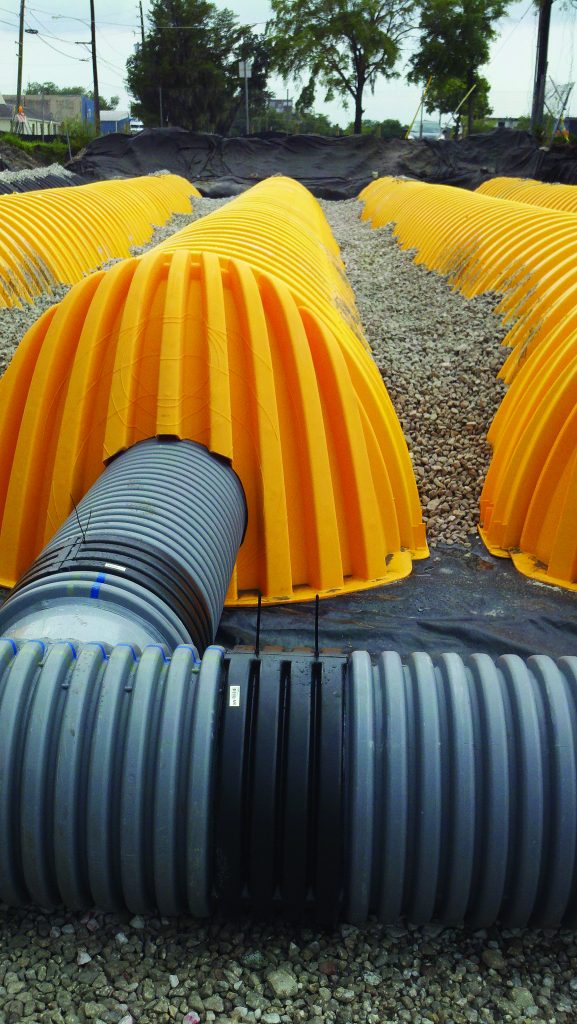Stuart Crisp, UK manager of Advanced Drainage Systems (ADS), highlights the possible causes of failure that would-be asset owners should be aware of.

There’s a challenge with underground attenuation assets. By their very nature, they are buried. Given that third-party inspection during construction and post-construction surveys and snagging are not always undertaken, this can result in mistakes going unnoticed and a higher risk of failure.
As we anticipate the implementation of Schedule 3 of the Flood and Water Management Act 2010, which will mandate the use of SuDS for new developments in England and set up bodies to adopt them, this issue becomes ever more pertinent.
SuDS Approving Bodies (SABs) must be assured that they are minimising the adoption of avoidable liabilities along with the underground SuDS elements.
SABs should ensure that they know why design decisions were made, how products were chosen and whether they were re-specified by the contractor, how quality and technical checks were made and recorded, and the implications on performance, durability and maintenance throughout the asset’s service life.
Design
Designers should consider the performance and behaviour of an asset across its whole lifecycle including long-term and short-term loading, maintenance requirements, operation costs and end-of-life. To produce a robust specification for an underground attenuation device, they must understand how standards and guidance apply to structural performance, material behaviour, product design, manufacture and installation methodology, since all these factors contribute to the asset’s integrity and durability.

The SuDS system design must take into account the amount, concentration and types of pollutants to be expected in the storm water runoff and the respective treatment flow rates for the components used in the management train, as well as hydraulic flow rates. Failure to take maximum treatment flow rates into account can compromise the efficiency of the treatment device, and hence water quality passing through the system.
The design must also consider maintenance and inspection regimes, including cost, frequency, access for vehicles and the type of equipment that will be deployed.
Product selection
The decision on the type of underground SuDS attenuation may ultimately fall to an engineer, developer, contractor or even a sub-subcontractor. However, those making decisions about product choice may not have all the knowledge they need to understand the implications.
For instance, upstream sediment capture devices may be removed or down-sized because there isn’t a perceived risk of a high pollution load but if using a hard-to-clean attenuation system, such as many types of geocellular crates, that would mean that the size of the crate tank should be increased by 10% as its volume will reduce over time due to sediment build-up (ref CIRIA C753 The SuDS Manual clause 21.5.3 and table 21.2).
De-specification to choose cheaper products can increase the risks of failure. An alternative below-ground SuDS attenuation product may appear to perform in the same way, but adopting bodies and asset owners should check that they meet all the relevant standards and that they have undergone the appropriate certification and testing.
Installation
Poor workmanship can often be the reason for failure. An easy-to-install system saves time for the installer and reduces risk for the contractor and asset owner. Systems with multiple components and fixings require higher levels of skill and supervision and introduce more risk because time pressures, or parts missed-out during assembly, can lead to mistakes.
Connections and interfaces are important too. The ‘gut feel’ of how an operative thinks something should be installed may not match-up with what the designer and the manufacturer actually require.
Maintenance
The frequency and ease of maintenance of SuDS system will come under close scrutiny once SABs are preparing to adopt assets because these factors will influence the commuted sum that a developer must hand over on adoption of the asset.
In addition to an overall design that provides good access for vehicles and people, the design of the product is important. Asset owners must think about ease of cleaning sediment from the tank and any upstream treatment devices, and whether standard cleaning or specialist equipment is required.
Avoiding failure
Due diligence for any would-be asset owner must cover decisions made at all stages of the design and delivery of an underground SuDS attenuation device.
Failure to do this risks failure of the system through poor performance, or higher maintenance and repair costs than forecasted.

Stuart Crisp is UK Manager for Advanced Drainage Systems (ADS). ADS is America’s largest manufacturer of thermoplastic corrugated drainage pipes and a specialist in water management systems. StormTech has a long and successful track record with over 50,000 below ground SuDS attenuation system installations using in excess of 3m units.
Originally published in Water magazine October 2024